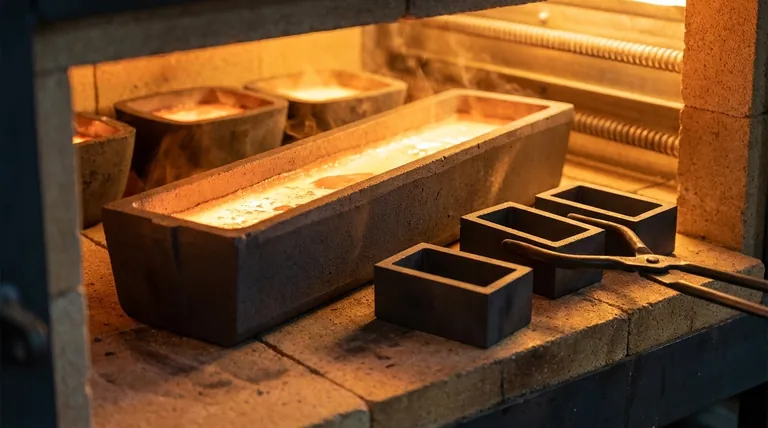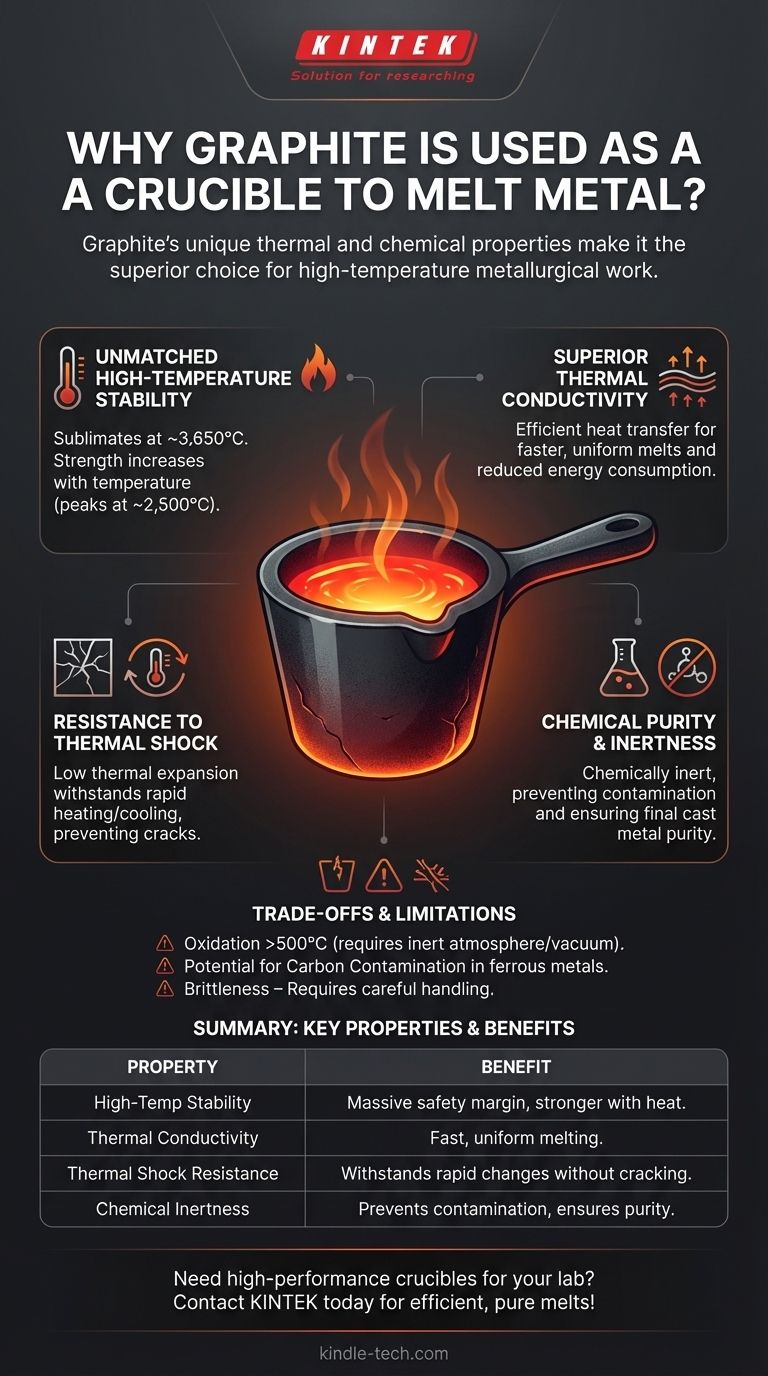In short, graphite is used for melting metals because of its extraordinary ability to withstand extreme heat without melting, its resistance to cracking from rapid temperature changes, and its general refusal to chemically react with or contaminate the molten metal inside. This unique combination of properties makes it a superior and reliable container for high-temperature metallurgical work.
The core reason for graphite's dominance as a crucible material is its unparalleled thermal stability. Unlike most materials that weaken with heat, graphite actually gets stronger as it gets hotter, all while efficiently transferring heat and resisting the thermal shock that would shatter lesser materials.

The Core Properties of a Graphite Crucible
To understand why graphite is the material of choice, we must look at the specific challenges of containing molten metal. The ideal crucible must master four distinct physical demands.
Unmatched High-Temperature Stability
Graphite does not have a traditional melting point at atmospheric pressure. Instead, it sublimates (turns directly from a solid to a gas) at an incredibly high temperature, around 3,650°C (6,602°F).
This provides a massive operational safety margin, as this temperature is far above the melting point of nearly all common and precious metals, including steel, platinum, and gold.
Remarkably, graphite's tensile strength increases with temperature, peaking at around 2,500°C. This counter-intuitive property means the crucible becomes more robust precisely when it is under the most thermal stress.
Superior Thermal Conductivity
Graphite possesses very high thermal conductivity. This is a critical feature, not a drawback.
Efficient heat transfer ensures that energy from the furnace is passed quickly and evenly through the crucible walls to the metal charge inside. This results in a faster, more uniform melt and reduces energy consumption.
Resistance to Thermal Shock
Thermal shock is what causes a cold glass to crack when hot water is poured into it. Graphite has an extremely low coefficient of thermal expansion.
This means it does not expand or contract significantly when its temperature changes rapidly. This property gives it exceptional resistance to the immense stress of heating and cooling cycles, preventing cracks and catastrophic failure.
Chemical Purity and Inertness
Graphite is chemically inert and is not "wetted" by most molten metals. This means the molten metal does not stick to or react with the crucible walls.
This non-reactivity is vital for maintaining the purity of the final cast metal, preventing unwanted alloys or contaminants from leaching out of the crucible and into the melt.
Understanding the Trade-offs and Limitations
While graphite's properties make it ideal, it is not without its weaknesses. Understanding these limitations is key to using it correctly.
The Critical Challenge of Oxidation
Graphite's primary vulnerability is its reaction with oxygen at high temperatures. In the presence of air, graphite will begin to oxidize (essentially, burn away) at temperatures above 500°C (932°F).
This erosion weakens the crucible, shortening its lifespan. For this reason, graphite crucibles are best used in vacuum or inert atmosphere furnaces (using argon or nitrogen) to protect them from oxygen exposure. For open-air forging, composite crucibles like clay-graphite or silicon carbide are often used to provide better oxidation resistance.
Potential for Carbon Contamination
While generally inert, graphite is pure carbon. When melting certain metals, particularly iron and steel, some carbon from the crucible can dissolve into the melt.
This can be a deliberate feature in steelmaking, where carbon content is precisely controlled. However, if the goal is to melt a low-carbon steel or pure iron without altering its composition, this carbon pickup must be accounted for, or an alternative ceramic crucible (like alumina or magnesia) may be required.
Brittleness and Handling
Like other ceramic-type materials, graphite is brittle. It can easily be cracked or chipped if dropped or subjected to sharp mechanical impacts.
Proper storage and careful handling, especially when hot and at its maximum strength, are essential to ensure a long service life.
Making the Right Choice for Your Application
Choosing the right crucible depends entirely on the metal being melted and the furnace environment.
- If your primary focus is melting precious metals or non-ferrous alloys (gold, silver, aluminum, brass): Graphite is the industry standard due to its excellent thermal performance and non-reactivity, which guarantees purity.
- If your primary focus is melting ferrous metals (iron, steel): Graphite is an excellent and cost-effective choice, but you must be prepared for some degree of carbon transfer into your melt.
- If your primary focus is working in an open-air furnace: A pure graphite crucible is unsuitable. You must use a composite crucible (clay-graphite, silicon carbide) or a ceramic crucible to withstand oxidation.
Ultimately, graphite's exceptional performance in controlled, high-temperature environments makes it the definitive material for reliably and cleanly melting metal.
Summary Table:
| Key Property | Why It Matters for Melting Metal |
|---|---|
| High-Temperature Stability | Sublimates at 3,650°C; crucible gets stronger with heat, providing a massive safety margin. |
| Superior Thermal Conductivity | Ensures fast, uniform melting and reduces energy consumption. |
| Resistance to Thermal Shock | Withstands rapid heating/cooling without cracking, ensuring longevity. |
| Chemical Inertness | Prevents contamination, guaranteeing the purity of precious and non-ferrous metals. |
Need a reliable crucible for your lab's metal melting applications? KINTEK specializes in high-performance lab equipment, including crucibles designed for superior thermal management and purity. Our experts can help you select the perfect graphite or ceramic crucible for your specific metal and furnace environment. Contact us today to ensure your melts are efficient, pure, and reliable!
Visual Guide

Related Products
- High Purity Pure Graphite Crucible for Evaporation
- Engineering Advanced Fine Ceramics Alumina Crucibles (Al2O3) for Thermal Analysis TGA DTA
- Engineering Advanced Fine Ceramics Alumina Al2O3 Crucible With Lid Cylindrical Laboratory Crucible
- Custom Machined and Molded PTFE Teflon Parts Manufacturer with PTFE Crucible and Lid
- Alumina Al2O3 Ceramic Crucible Semicircle Boat with Lid for Engineering Advanced Fine Ceramics
People Also Ask
- What temperature does evaporation occur? Unlock the Secrets to Controlling the Rate of Evaporation
- What does PVD sputtering mean? A Guide to High-Performance Thin Film Deposition
- What is the difference between VAR and ESR? A Guide to Understanding Tail Risk in Financial Modeling
- How is sputtering done? A Step-by-Step Guide to Thin Film Deposition
- How can different materials have different heat capacity? Unlocking the Microscopic Secrets of Energy Storage



















